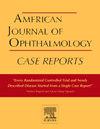Pigmented perivascular epithelioid cell tumors of the orbit with NONO::TFE3 fusion: Molecular evaluation and literature review
Q3 Medicine
引用次数: 0
Abstract
Purpose
To elucidate the clinical characteristics of rare orbital pigmented perivascular epithelioid cell tumors (PEComa) with transcription factor E3 (TFE3) rearrangement through a literature review.
Observations
A 49-year-old female was referred to our hospital with a mass measuring 16 × 14 mm in the extraconal space of the right orbit. Suspecting hemangioma or distended hematoma clinically, the tumor was completely excised through the right nasal conjunctiva. Although initial histological evaluation raised the suspicion of malignant melanoma, subsequent immunohistochemistry and molecular analyses led to a diagnosis of TFE3-rearranged PEComa with the NONO::TFE3 fusion gene. The patient's visual function was preserved 14 months postoperatively, with no evidence of recurrence.
Conclusions and importance
Although rare, TFE3-rearranged PEComa should be considered in the differential diagnosis of pigmented orbital tumors.
眼眶色素血管周围上皮样细胞瘤与NONO::TFE3融合:分子评价和文献复习
目的通过文献复习,探讨罕见的眼眶色素样血管周围上皮样细胞瘤(PEComa)伴转录因子E3 (TFE3)重排的临床特点。患者为女性,49岁,右眼眶外腔肿块16 × 14 mm。临床怀疑为血管瘤或扩张性血肿,经右鼻结膜完全切除肿瘤。虽然最初的组织学评估引起了恶性黑色素瘤的怀疑,但随后的免疫组织化学和分子分析导致诊断为带有NONO::TFE3融合基因的TFE3重排PEComa。术后14个月视力保持正常,无复发迹象。结论及重要性tfe3重排PEComa虽然罕见,但在眼眶色素性肿瘤的鉴别诊断中应予以考虑。
本文章由计算机程序翻译,如有差异,请以英文原文为准。
求助全文
约1分钟内获得全文
求助全文
来源期刊

American Journal of Ophthalmology Case Reports
Medicine-Ophthalmology
CiteScore
2.40
自引率
0.00%
发文量
513
审稿时长
16 weeks
期刊介绍:
The American Journal of Ophthalmology Case Reports is a peer-reviewed, scientific publication that welcomes the submission of original, previously unpublished case report manuscripts directed to ophthalmologists and visual science specialists. The cases shall be challenging and stimulating but shall also be presented in an educational format to engage the readers as if they are working alongside with the caring clinician scientists to manage the patients. Submissions shall be clear, concise, and well-documented reports. Brief reports and case series submissions on specific themes are also very welcome.
 求助内容:
求助内容: 应助结果提醒方式:
应助结果提醒方式:


